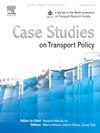Evacuation planning in urban areas: A case study in Galați under military conflict conditions
IF 2.4
Q3 TRANSPORTATION
引用次数: 0
Abstract
Emergency shelters in urban areas play an important role in providing temporary refuge to the population in military conflicts. The aim of this article is to examine the spatial alignment of shelters to the population distribution in the event of a war in Galaţi (Romania). The capacity of the emergency shelters, the possible number of evacuees and the transport behaviour of the inhabitants are the three main factors considered in these studies. The survey was conducted using the CATI technique with a sample of 405 residents (from 1 March to 12 April 2023). The results indicate that only a relatively small percentage of residents are willing to self-evacuate. Despite this, the situation can still be considered favourable as self-evacuation may cause a number of problems if many people who have no knowledge about wartime evacuation procedures use their own cars to self-evacuate. The analysis of the distribution of emergency services (fire brigades and the police force) in the city reveals that it is adequate relative to the population distribution. However, these forces are limited in number and can quickly become overwhelmed without proper management. Furthermore, the capacity of the existing emergency shelters in the studied city is insufficient, both for self-evacuation on foot or by car. Thus, new locations for emergency shelters have been recommended to be located in existing facilities in order to accommodate the largest possible number of people in the shortest possible time. The approach taken in this study can also be adopted to serve in other urban areas facing similar risks, emphasising the need for a tailored crisis management strategy that takes into account specific regional and population dynamics.

城市地区的疏散规划:军事冲突条件下Galați的案例研究
城市地区的紧急避难所在向军事冲突中的民众提供临时避难所方面发挥着重要作用。本文的目的是研究在Galaţi(罗马尼亚)发生战争时避难所与人口分布的空间排列。紧急避难所的容量、可能的撤离人数和居民的交通行为是这些研究中考虑的三个主要因素。该调查采用CATI技术对405名居民进行了抽样调查(从2023年3月1日至4月12日)。结果表明,只有相对较小比例的居民愿意自行撤离。尽管如此,如果许多不了解战时撤离程序的人使用自己的汽车进行自我撤离,可能会造成一些问题,因此情况仍然是有利的。对该市应急服务(消防队和警察部队)分布的分析表明,相对于人口分布而言,这是适当的。然而,这些力量数量有限,如果没有适当的管理,很快就会被淹没。此外,所研究城市现有应急避难所的能力不足,无论是步行还是开车自行疏散。因此,建议在现有设施内设立新的紧急避难所,以便在尽可能短的时间内容纳尽可能多的人。本研究采用的方法也可用于面临类似风险的其他城市地区,强调需要制定考虑到具体区域和人口动态的量身定制的危机管理战略。
本文章由计算机程序翻译,如有差异,请以英文原文为准。
求助全文
约1分钟内获得全文
求助全文

 求助内容:
求助内容: 应助结果提醒方式:
应助结果提醒方式:


